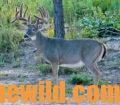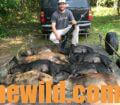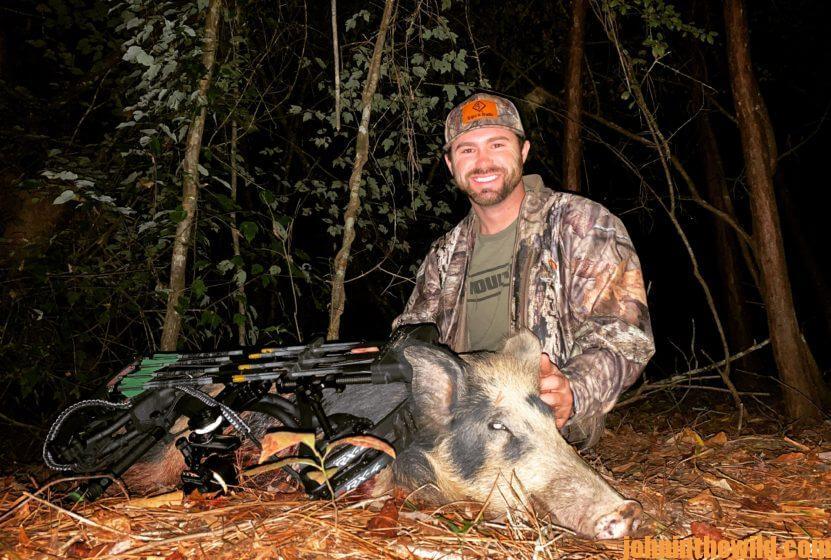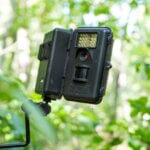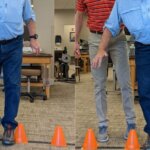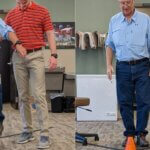Editor’s Note: For the most part, feral hogs are destructive. They’ll tear-up culverts, roads and green fields and root-up wildlife plantings and agriculture. Many people enjoy eating wild pigs. In the South, you generally can fill-up your freezer with all the wild pork you want to eat. In most areas with wild hogs, the hogs reproduce faster than hunters can take them, eat them and/or give away the meat. Female feral pigs can reach sexual maturity at 3-4 months of age and have two litters per year of up to 12 piglets each. Male feral hogs are sexually mature at 4-5 months. Slade Johnston of Tuscaloosa, Alabama, has found a way to enjoy more free hunting and fishing trips by using hunting hogs as a trade item. People who have game that Johnston wants to hunt can trade him a hunting trip to their areas to hunt the game he’s interested in, and in exchange, he hosts them on an Alabama wild-hog hunting trip. Whether you want to take meat hogs to eat or a trophy boar with long teeth to mount, Johntson may have a trip to offer you. Johnston has access to private hunting lands that have been passed down through his family in the game-rich section of the state known as the Black Belt. Due to the rich soil there, this family-owned land produces a good number of turkeys and deer and outstanding numbers of feral hogs. To learn more, visit https://trips4trade.com/ and the Facebook page https://www.facebook.com/trips4trade/.
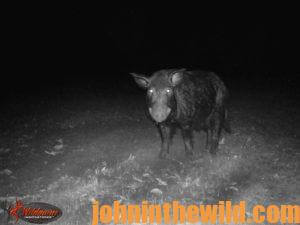 Our family farm is on the Sumter County/Choctaw County line between York and Ward, Ala. My mother’s grandmother grew up on this property, and her father and grandfather owned plenty of land in this area. This land has been passed down from generation to generation. My grandfather, Gary Fortenberry, who married my grandmother with the land, was an avid hunter of both deer and turkeys. Any money he had that wasn’t spent on his family or given to his church went to buy new land to add to the family farm and to pay for new hunting leases. He wanted to purchase the leases or to buy any lands adjoining our properties. Our family always has been conservation-minded and has wanted our lands to produce as much wildlife as possible.
Our family farm is on the Sumter County/Choctaw County line between York and Ward, Ala. My mother’s grandmother grew up on this property, and her father and grandfather owned plenty of land in this area. This land has been passed down from generation to generation. My grandfather, Gary Fortenberry, who married my grandmother with the land, was an avid hunter of both deer and turkeys. Any money he had that wasn’t spent on his family or given to his church went to buy new land to add to the family farm and to pay for new hunting leases. He wanted to purchase the leases or to buy any lands adjoining our properties. Our family always has been conservation-minded and has wanted our lands to produce as much wildlife as possible.
Our family land is being used primarily as a timber investment today; however, our family passion is hunting and fishing – also my grandfather’s passion. We rotate timber tracts of pines, and we don’t cut any of our hardwoods. Back many years ago, our land was used to raise cattle and cotton, but now we use the property to produce wildlife, pines and timber.
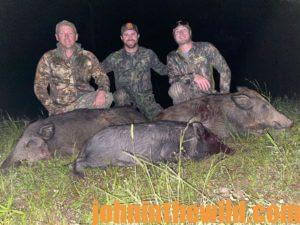 I think if landowners and hunting clubs have property that has hogs on it, ultimately, they have to be concerned with how to reduce the hog population and/or try to totally remove the hogs off their land, at least for a little while. Due to the rate at which the wild hog population can reproduce, totally eliminating hogs from a property is a dream come true. Reducing feral pig numbers each year can be very effective in increasing the number of deer, turkeys, and small game that live and raise their young – particularly on a small property. Although there are many reasons why turkey populations across the Southeast have been on a decline for the last several years, I know that feral hogs directly impact the number of turkeys that can be raised on a property. Hogs love turkey eggs and enjoy disturbing turkey nests. The more wild pigs we harvest, the more turkey poults the land can produce. I’ve learned too that hogs will eat your mast crop, and if you have supplemental feeders on your land, more than likely you’re feeding more wild pigs than you are deer. If you plant green fields, the hogs will root them up and keep the deer from coming to them. Managing your land for wildlife is very difficult, if you don’t use some method of eliminating wild hogs on the lands you hunt. My grandmother and her family still live on this property. They can’t have lawns and cut them with a lawnmower because the feral hogs are constantly rooting-up the grass in the front and the back yards.
I think if landowners and hunting clubs have property that has hogs on it, ultimately, they have to be concerned with how to reduce the hog population and/or try to totally remove the hogs off their land, at least for a little while. Due to the rate at which the wild hog population can reproduce, totally eliminating hogs from a property is a dream come true. Reducing feral pig numbers each year can be very effective in increasing the number of deer, turkeys, and small game that live and raise their young – particularly on a small property. Although there are many reasons why turkey populations across the Southeast have been on a decline for the last several years, I know that feral hogs directly impact the number of turkeys that can be raised on a property. Hogs love turkey eggs and enjoy disturbing turkey nests. The more wild pigs we harvest, the more turkey poults the land can produce. I’ve learned too that hogs will eat your mast crop, and if you have supplemental feeders on your land, more than likely you’re feeding more wild pigs than you are deer. If you plant green fields, the hogs will root them up and keep the deer from coming to them. Managing your land for wildlife is very difficult, if you don’t use some method of eliminating wild hogs on the lands you hunt. My grandmother and her family still live on this property. They can’t have lawns and cut them with a lawnmower because the feral hogs are constantly rooting-up the grass in the front and the back yards.
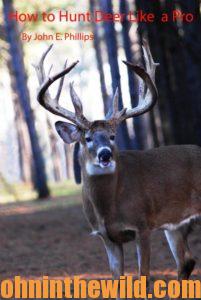 Wild pigs love to eat deer food, one of the primary reasons for removing them. To learn more about hunting deer, check out John E. Phillips’ book, “How to Hunt Deer Like a Pro,” available in Kindle, Print and Audible versions, at (http://amzn.to/YpoQHA). You may have to copy and paste this link into your browser. (When you click on this book, notice on the left where Amazon says you can read 10% of the book for free, and you can hear 10% for free).
Wild pigs love to eat deer food, one of the primary reasons for removing them. To learn more about hunting deer, check out John E. Phillips’ book, “How to Hunt Deer Like a Pro,” available in Kindle, Print and Audible versions, at (http://amzn.to/YpoQHA). You may have to copy and paste this link into your browser. (When you click on this book, notice on the left where Amazon says you can read 10% of the book for free, and you can hear 10% for free).
To learn more about other deer books by John E. Phillips, go to www.amazon.com/author/johnephillips.

